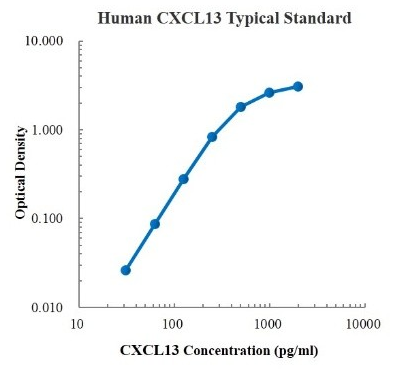| Description | Detection Principle: This kit uses double antibody sandwich ELISA technology. The specific anti human CXCL13 capture antibody was pre coated on a high affinity microplate. Add the standard, the sample to be tested and the biotin labeled detection antibody into the wells of the enzyme plate in turn, shake well and mix well, and then place it at room temperature for 2 hours of incubation process. The CXCL13 present in the sample is combined with the solid-phase antibody and the detection antibody. After washing sufficiently to remove free and unbound components, streptavidin HRP (sa-hrp) labeled with horseradish peroxidase was added. After washing again, TMB chromogenic substrate was added and incubated at room temperature in the dark to develop color. The depth of color response is positively correlated with the concentration of CXCL13 in the sample. Add stop solution to stop the reaction, and use a microplate reader to measure the absorbance value at 450 nm detection wavelength (correction wavelength 570-630 nm). Detection Type: Double antibody sandwich method Form: Pre coated 96 well plate Test Sample Type: cell supernatant, serum, plasma Loading Amount: 100 μ L Kit Components: A copy of pre coated 96 well plate, standard, CXCL13 detection antibody, standard dilution, detection buffer, TMB chromogenic substrate, washing solution, termination solution, sa-hrp, plate sealing membrane and instructions. Sensitivity: 4.86pg/ml Detection Range: 31.3-2000 pg/ml Recovery Range: 87-114% Storage Method: 2-8 ℃ Standard Curve: 
Background: Chemokine CXC ligand 13 (CXCL13) is also known as B lymphocyte chemokine (BLC)Or bca-1, which is highly expressed in human liver, spleen, lymph nodes and intestine. It selectively exerts chemotaxis on B cells belonging to B-1 and B-2 subpopulations and exhibits its function by interacting with chemokine receptor CXCR5. CXCL13 and its receptor CXCR5 regulate B cell architecture in lymphoid tissue follicles. Among T cells, CXCL13 expression is thought to reflect the origin of T cells, especially follicular helper T cells (TFH) germinal centers. Therefore, CXCL13 expression in T-cell lymphomas, such as angioimmunoblastic T-cell lymphoma, is thought to reflect the origin of tumor T-cell germinal centers. |





